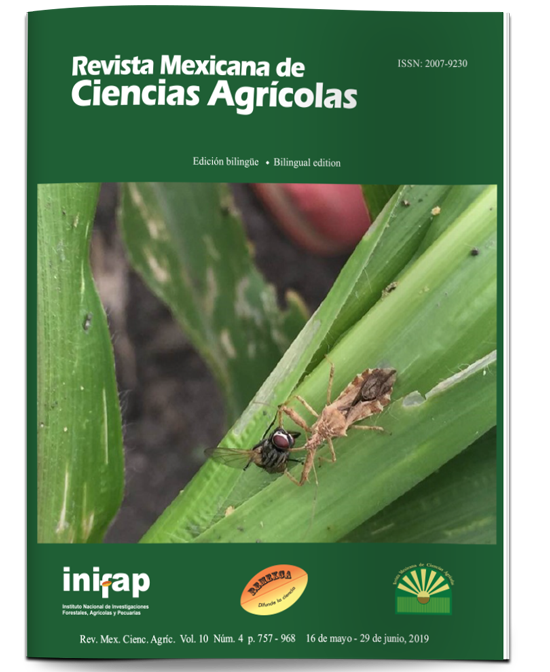Genotype interaction by environment of yellow corn yield in trilinear hybrids, Peru
DOI:
https://doi.org/10.29312/remexca.v10i4.1696Keywords:
Zea mays L., adaptation and stability, AMMI model, grain yield, trilinear hybridsAbstract
The use of trilinear hybrids in the genetic improvement program of corn (Zea mays L.) has increased in recent decades, since it has the advantage of obtaining greater grain yield caused by heterosis. The AMMI model (main additive effects and multiplicative interactions) has demonstrated its ability to analyze stability, adaptation and genotype interaction by environment (IG*A). The objective of this investigation was to determine the stability and the IG*A of the yield of 25 yellow corn hybrids evaluated in five environments of Peru, between the years 2014-2015. Three environments belonged to the coastal zone and two to the low deciduous forest, using a 5x5 latice design with four repetitions. The AMMI model was useful to determine the stability and adaptation of the genotypes, both characteristics were expressed in the two biplot graphs of the same model, such graphs explained 49.42% and 70.47% of the IG*A, respectively. The two genotypes with the highest grain yield were the trilinear hybrids CML226xHPM302 and POOL26xHPM302 with 8.153 and 8.08 t ha-1, respectively, with good stability and acceptable adaptation to the IG*A. On the other hand, the only simple hybrid HPM302 was stable but with the lowest performance (6.151 t ha-1). On the other hand, edaphoclimatic conditions were decisive for the environments of La Molina: LM-2015 was the most stable of the five environments and LM-2014 turned out to have the highest yield (9.424 t ha-1) discriminating between genotypes, with the components of the IG*A positive.
Downloads
Downloads
Published
How to Cite
Issue
Section
License
The authors who publish in Revista Mexicana de Ciencias Agrícolas accept the following conditions:
In accordance with copyright laws, Revista Mexicana de Ciencias Agrícolas recognizes and respects the authors’ moral right and ownership of property rights which will be transferred to the journal for dissemination in open access. Invariably, all the authors have to sign a letter of transfer of property rights and of originality of the article to Instituto Nacional de Investigaciones Forestales, Agrícolas y Pecuarias (INIFAP) [National Institute of Forestry, Agricultural and Livestock Research]. The author(s) must pay a fee for the reception of articles before proceeding to editorial review.
All the texts published by Revista Mexicana de Ciencias Agrícolas —with no exception— are distributed under a Creative Commons License Attribution-NonCommercial 4.0 International (CC BY-NC 4.0), which allows third parties to use the publication as long as the work’s authorship and its first publication in this journal are mentioned.
The author(s) can enter into independent and additional contractual agreements for the nonexclusive distribution of the version of the article published in Revista Mexicana de Ciencias Agrícolas (for example include it into an institutional repository or publish it in a book) as long as it is clearly and explicitly indicated that the work was published for the first time in Revista Mexicana de Ciencias Agrícolas.
For all the above, the authors shall send the Letter-transfer of Property Rights for the first publication duly filled in and signed by the author(s). This form must be sent as a PDF file to: revista_atm@yahoo.com.mx; cienciasagricola@inifap.gob.mx; remexca2017@gmail.
This work is licensed under a Creative Commons Attribution-Noncommercial 4.0 International license.



